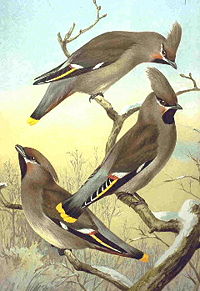Waxwing
| Waxwing | ||||||||||||||
|---|---|---|---|---|---|---|---|---|---|---|---|---|---|---|
 Bohemian Waxwings
|
||||||||||||||
| Scientific classification | ||||||||||||||
|
||||||||||||||
| Species | ||||||||||||||
|
- For the Seattle band featuring Rocky Votolato, see Waxwing (band). For the Detroit band featuring Dean Fertita, see The Waxwings.
The waxwings form the genus Bombycilla of passerine birds. According to most authorities, this is the only genus placed in the family Bombycillidae.
Contents |
Description
Waxwings are characterised by soft silky plumage and unique red tips to some of the wing feathers. In the Bohemian and Cedar Waxwings, these tips look like sealing wax, and give the group its name. The legs are short and strong, and the wings are pointed. The male and female have the same plumage. All three species have mainly brown plumage, a black line through the eye and black under the chin, a square-ended tail with a red or yellow tip, and a pointed crest. The bill, eyes, and feet are dark. Calls are high-pitched, buzzing or trilling monosyllables (Sibley 2000, MacKinnon and Phillipps 2000).
Diet
These are arboreal birds that breed in northern forests (Witmer and Avery 2003). Their main food is fruit, which they eat from early summer (strawberries, mulberries, and serviceberries) through late summer and fall (raspberries, blackberries, cherries, and honeysuckle berries) into late fall and winter (juniper berries, grapes, crabapples, mountain ash fruits, rose hips, cotoneaster fruits, dogwood berries, and mistletoe berries) (MacKinnon and Phillipps 2000, Witmer and Avery 2003). They pluck fruit from a perch or occasionally while hovering. In spring they replace fruit with sap, buds, and flowers. In the warmer part of the year they catch many insects by gleaning or in midair, and often nest near water where flying insects are abundant (Witmer and Avery 2003).
Reproduction
Waxwings also choose nest sites in places with rich supplies of fruit and breed late in the year to take advantage of summer ripening. However, they may start courting as early as the winter. Pairing includes a ritual in which mates pass a fruit or small inedible object back and forth several times until one eats it (if it is a fruit). After this they may copulate. So that many birds can nest in places with good food supplies, a pair does not defend a territory—perhaps the reason waxwings have no true song—but a bird may attack intruders, perhaps to guard its mate. Both birds gather nest materials, but the female does most of the construction, usually on a horizontal limb or in a crotch well away from the tree trunk, at any height. She makes a loose, bulky nest of twigs, grass, and lichen, which she lines with fine grass, moss, and pine needles and may camouflage with dangling pieces of grass, flowers, lichen, and moss. The female incubates, fed by the male on the nest, but once the eggs hatch, both birds feed the young (Witmer and Avery 2003).
Movements
They are not true long-distance migrants, but wander erratically outside the breeding season and move south from their summer range in winter. In poor berry years huge numbers can erupt well beyond their normal range, often in flocks that on occasion number in the thousands (Witmer and Avery 2003).
Relationships
Some authorities (including the Sibley-Monroe checklist) place some other genera in the family Bombycillidae along with the waxwings. Birds that are sometimes classified in this way include the silky-flycatchers, the Hypocolius, and the Palm Chat.
Species
- Bohemian Waxwing, B. garrulus
- Japanese Waxwing, B. japonica
- Cedar Waxwing, B. cedrorum
Quotation
I was the shadow of the waxwing slain
By the false azure in the windowpane
These are the first lines of the poem "Pale Fire" by "John Shade," a fictional poet created by Vladimir Nabokov, for his novel Pale Fire.
References
- MacKinnon, John; Phillipps, Karen (2000). A Field Guide to the Birds of China. Oxford University Press, USA. pp. 286–287. ISBN 0-19-854940-7.
- Sibley, David Allen (2000). The Sibley Guide to Birds. Alfred Knopf. pp. 423. ISBN 0-679-45122-6.
- Witmer, Mark; Avery, Mark (2003). "Waxwings and Silky Flycatchers". in Perrins, Christopher. The Firefly Encyclopedia of Birds. Firefly Books. pp. 518–519. ISBN 1-55297-777-3.
External links
- Waxwing videos on the Internet Bird Collection